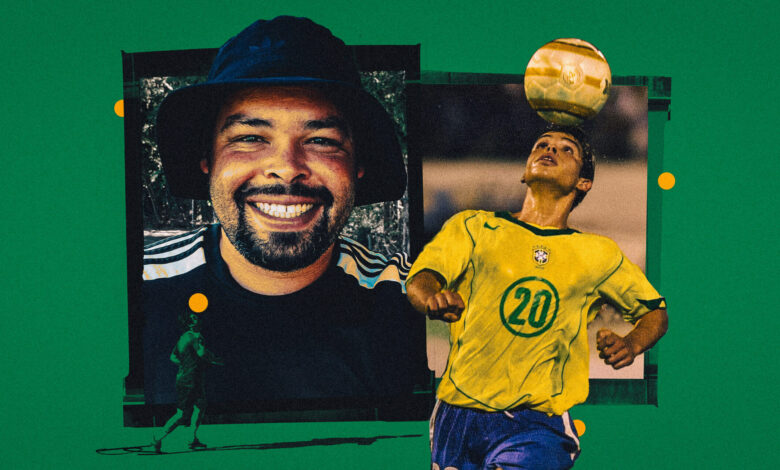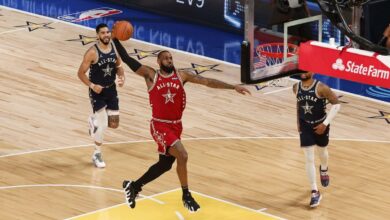In search of Kerlon and his seal dribble

This was going to be about the search.
It was going to be one of those pieces with an absence at its heart, a kind of magical mystery write-around, Frank Sinatra Has A Cold for the Brazilian football heads.
Sometimes you get the interview. Sometimes you just have to shrug and tell the story without it. A version of the story, anyway.
That is how it was shaping up with Kerlon Moura Souza. It was going to be a long-distance profile, the story of one of the game’s strangest parlour tricks and its creator, told through the hazy prism of memory. I had dug out the videos of the dribble that made him famous and watched them countless times. Maybe it was better this way, I told myself. Nothing ruins a folk tale like interrogating the logic of its plot points.
It wasn’t that I hadn’t tried. No, the trying was going to be a big part of it. The plan was to really ham things up, to make a fruitless and objectively quite dull pursuit sound something like spycraft.
I was going to reference the pleading emails I had sent him across a period of years; the time spent tracking his whereabouts from my bedroom; the Instagram messages to his personal and business accounts; the hopeful enquiry to one of his employers. All of which yielded a grand total of… nada. A big old nothing sandwich with a side of radio silence.
As time went on, I often imagined what the title might be. ‘The Hunt for the Seal Dribbler’, perhaps. Or, if that oblique reference to his trademark move didn’t cut it with my editor, something a little more on-the-nose. ‘Kerlon: An Unrequited Love Story’ would have worked just fine.
Earlier this year, I decided the moment had come. Enough waiting, enough frustration. I was going to do it, going to write the piece, going to finally tick it off my list and forget about it.
Then I found him.
Once upon a time, there was a boy. The boy was a talented footballer. He was nippy, skilful and strong. People thought he was going to be a star one day. In many cases, that is as far as the fable goes. It is normally enough to suck people in.
This particular boy, though, also had something else. He had a special move, an invention all of his own. He could make the ball stick to his forehead. He could flick it up and just… keep it there, gravity be damned. It went with him wherever he went. He could run, even change direction, and still it stayed there, just above his eyeline, a little round pet.
Some people loved the boy, loved his trick. It was fun and it was funny in the way that unusual things can be. If anyone had thought to do it before, they had given up long before showing it off. But the boy wasn’t embarrassed and he wasn’t scared. He did the trick even when he knew it would end in tears, even after it had begun to turn strangers into enemies.
The trick made the boy famous. It also made him a target.
The kids are leaving when I arrive. They shuffle off with their parents into cars and trucks, exhausted but happy. Day two of their week-long summer football camp is over.
It is just after midday in Hemby Bridge, a commuter town just southeast of Charlotte, North Carolina. The air is hot and heavy with moisture; my T-shirt begins to stick to my back soon after I step out of the taxi. It doesn’t help that I am jogging, frantically plotting a path to the rear of the local elementary school, trying to get to the sports pitches before Kerlon leaves.
He is not expecting me. I don’t know what to expect of him.
As I approach across the grass, a man is packing the last bag of footballs into the boot of his car. He wears a bucket hat and a black training shirt. He is tanned and stocky, facial hair cropped into a neat goatee. It’s him.
I shout out his name. A grin spreads across his face.
He is gracious and friendly. He says he has lunch planned with his family, but that he will talk if I come back tomorrow, bright and early, before training. I tell him he has a deal.
Kerlon was famous before he had even played first-team football. It was an inevitability: the trick — first dusted off at youth level for Cruzeiro, then for Brazil’s under-17 side — was always destined to make waves.
For one thing, it was just so odd, so wilfully off-kilter. There are a thousand ways to dribble past an opponent, but until Kerlon came along, they pretty much all involved the feet. To watch him set off on a run, ball bobbling up and down on his brow, was to be forced to resolve what instinctively felt like a category error. Little wonder that defenders did not seem to know what to do with him in the early days; it’s hard to counteract something you can barely even understand.
The element of surprise did not last. This was the mid-2000s, probably slightly too early for the trick to be called a viral sensation, but clips of it soon started doing the rounds. One, originally posted on YouTube in December 2005, has been watched over 3.7million times since. The seal dribble, people called the move, a name that conjured colourful circus images. Kerlon swiftly became O Foquinha — The Little Seal — and it wasn’t long before his club were selling seal toys, looking to cash in on his name.

Kerlon became O Foquinha — The Little Seal (Daniel de Cerqueira/AFP via Getty Images)
There was more to Kerlon’s game than his trademark move. He was top scorer for Brazil at the South American Under-17 Championship in Venezuela, outshining future senior internationals Marcelo, Renato Augusto and Anderson. The title of another popular YouTube video compared him to Ronaldinho and while that was certainly on the generous side, Kerlon could be similarly effervescent on his day. He could hurt opposition teams with his passing, with his finishing and with his dead-ball ability. Still, everything always came back to the dribble.
Brazil went loopy for Kerlon’s dribble in a way that maybe only Brazil could. This was football as improvisational theatre, as streetwise problem-solving and, above all, as unrefined play. The seal dribble was experimental, naive curiosity supercharged by technique. It was ludic and it was ludicrous — not the thing itself, necessarily, although it did have a certain came-up-with-this-after-six-beers energy. No, the ludicrous part was that Kerlon would do it in actual matches.
He did it in the South American Championship against Colombia and Uruguay. Later, he did it for Cruzeiro in a local derby, sparking a mass brawl and a moral panic. But we’ll get to that later.

Kerlon performing his signature skill (AP Photo/Ana Maria Otero)
Beneath trees that sway in the morning breeze, Kerlon gets as comfy as the wooden bench will allow. We’re a little behind schedule — training starts in 20 minutes — so there is no great preamble, no backlift. Slowly but confidently, Kerlon just launches into the story of the trick that changed his life.
“When I was a very young kid, I would train a lot with my dad,” he says. “Just us two. One day he kicked the ball up high for me. It bounced on the floor and came up to my head. I did four or five little headers in a row, keeping the ball up. My dad stopped. He asked, ‘If you ran with the ball on your head like that, would it be a free kick?’. I said that I didn’t know but that we should find out. My dad looked up the rules and saw that it was legal. There was no issue with it.”
Kerlon’s father, Silvino, asked him to keep practising the move. At first, he would do it on the spot. Later, he tried it while walking in a straight line. “Then I would keep it up while running and finally I did it with cones, dribbling around them like they were opposition players,” explains Kerlon. “We worked on it every day in order to perfect it. It was a real process.”
When Kerlon had nailed the technique, Silvino began to think about how his son might use it in games. He bought a book on peripheral vision and incorporated that into the training regime, the idea being that Kerlon would be able to see opponents approaching even when he had the ball up high.
“It was the product of great dedication on his part,” says Kerlon. “It was easy for me to keep the ball up, but he worked out how it would work on the pitch. The strategy was all his.”
Kerlon was 13 when he first did the trick around other people. He had just joined Cruzeiro and was playing in midfield in an academy match.
“At one point, the opposition goalkeeper took a goal kick and it was just like it was in training with my dad,” he says. “My dad would hit the ball long and I would control it on my chest, lifting it into the air. The same happened in the game and off I went. The other kids just stopped. I kept going and kept going, from the middle of the field to the edge of the box. When I got to the penalty spot, I brought the ball down and scored. It was all so automatic.”
It was also proof of concept. Now that Kerlon and Silvino knew that the dribble could work, they doubled down on it. Kerlon kept practising the trick and often brought it out in matches — although never, he insists, just for the sake of it. He strongly rejects the notion that the seal dribble was some kind of gimmick.
“I think it was a solution I had available to me, a way of getting out of a tricky situation,” he says. “I never walked out onto the field planning to do it. It was just something that would happen naturally.”
It was predictable that certain people would come to view the move as a provocation. Dribbling is a blood sport at the best of times; this felt to some like an attempt to humiliate. At youth level, Kerlon would get tripped and kicked. By the time he was playing with adults, the worst challenges had started to look quite a lot like sucker punches.
Case in point: the Belo Horizonte derby in September 2007. Cruzeiro were beating Atletico Mineiro 4-3 with 10 minutes to play when Kerlon — a second-half substitute — flicked the ball onto his head following a short corner.
One, two, three touches later, Atletico full-back Coelho came along and shoulder-charged him into another dimension, making Kerlon’s head snap back with the impact. It was an awful, cynical challenge. A few seconds later, as players from both sides piled in, the scene looked like something from a martial arts movie.
The incident provoked a good deal of hand-wringing on both sides. Many thought Kerlon — the victim, by any sensible measure — was somehow to blame for the rough treatment.
“In the future, he could miss a lot of football,” said Atletico’s coach, Emerson Leao. “Maybe one day he does that, gets kicked in the face and never plays again.”
Luiz Alberto, the captain of rival club Fluminense, was even more explicit: “It’s disrespectful to his opponents. They are professionals, too. He wouldn’t get past me. I would use capoeira (an Afro-Brazilian martial art) moves if I had to. I would take the ball, his head and everything else.”
Kerlon, at least, was able to defend himself with eloquence beyond his years. “Fans go to the stadium to see a spectacle,” he said. “We need to decide what the main idea of Brazilian football is — art or violence.”

(AP Photo/Fernando Llano)
His advocates included, bizarrely, Atletico midfielder Maicosuel, as well as a number of readers of Placar magazine. “It brings people to the stadium in the same way Garrincha’s feints once did,” read one message of support, published on the letters page. “No-holds-barred fighters like that troglodyte Coelho must be punished.”
The best part of two decades later, Kerlon sees the funny side of it all. He says he realised early on that the seal dribble would be divisive.
“There was a lot of support for me in the youth sides,” he says, “but at senior level, even my own team-mates thought I shouldn’t do it. They would say I was asking for trouble. I had a few issues with the older ones. They really didn’t like it.”
What about his opponents? Did their violence get to him? Kerlon laughs. “No,” he says. “I liked it. When you love to play with freedom, when you love to dribble and beat your man, it feels good to get kicked. As long as you don’t get injured, it’s brilliant. It’s not a bad thing. It drives you on.
“You see that the other guy is pissed off with you, but you do it anyway because it’s part of your game. I think that’s cool. Look at Neymar. He feels good when he beats his man and gets fouled, when he can be a bit dramatic. That’s part of the Brazilian style.”

When it came to his coaches, some were more open to the trick than others. “A few of them thought it was unnecessary; others thought it put our team at risk,” he says. “I was always clear that I would never do the move in my own penalty area. I said I would only do it near the opposition box, where we might win a dangerous free kick or a penalty. The idea was to come up with something for the team, not for me.”
Even when he did get the green light, other issues emerged. Kerlon says one manager asked him to do the seal dribble straight from kick-off. “This is when I was playing for Sliema Wanderers in Malta,” he says. “The coach wanted Rafael Ledesma, the other Brazilian on the team, to flick the ball up for me as soon as the referee started the match. He explained this in a team talk before a match. All the other players just looked at me, as if to say, ‘Really?’.
“I said, ‘How am I going to do that? I’ll have 11 opposition players in front of me. What’s the point? What chance do I have?’. He said that I could win us a free kick. In the end, I told Ledesma to flick the ball up and I’d give it a go. But it was impossible. I took a couple of touches and then the other team just smashed into me. I injured my leg and had to go off. I didn’t even make it out of the centre circle.”
It is here that the other strand of Kerlon’s story — the diminishing returns, the gradual tumble down the slopes of the football pyramid — comes into focus.

(AP Photo/Fernando Llano)
The tide of early fanfare carried Kerlon to Italy — he moved to Inter Milan via Chievo and was represented by the late super agent Mino Raiola — but not much further. He never played a competitive match for Inter or for Ajax during a loan stint there. His next full-time employers were Fujieda MYFC in Japan. There was a fleeting spell in the U.S. with Miami Dade FC. After a handful of games in Malta and a few more in Slovakia, he retired in 2017, aged 29.
It would be easy to glance at that confounding CV and assume that Kerlon was never actually that good — that the seal dribble had written cheques that the rest of his game couldn’t cash. There may be a degree of truth to that, but the reality is that his body never allowed him to fully test the limits of his ability.
There were six ACL injuries — two of them while he was still in his teens — and a pair of serious ankle problems. Each one slowed him down. It was impossible to build up any semblance of momentum.
“I gradually lost my love for football,” he says. “After every surgery, I took six or seven months to fully recover. When I came back, it was hard to keep up, physically. Then I’d get injured again. I looked at other players and they would run up and down constantly. I tried to keep up but some muscle would go and I’d be out for three weeks.”
He endured it for as long as he could, but there was a limit. “Everything hurt by the end,” he says. “It was so bad. It wasn’t that I didn’t love football. It was that I didn’t want to be in pain anymore. That’s why I stopped.”
There is no bitterness in Kerlon’s voice. It helps that he is content with life in the U.S., his home for the last few years. He first moved to Connecticut, seeking job opportunities he felt were lacking in Brazil, then came down to North Carolina during the Covid pandemic. His family is happy and work is good: he is the technical director of the local soccer school and also puts on private sessions. “I love being involved in the game,” he says. “It’s what I know best.”
The American kids have a vague sense of his story, he says, but don’t get too excited by it. The relative anonymity suits him fine. He is happy with his legacy and has no huge desire to burnish it. He has done a couple of short interviews with Brazilian websites since retiring, but he ignores most requests. He got enough attention in those early years to last a lifetime.
“Today, I prefer a quiet life,” he says. “People tell me I have to get my name out there. No. The story is already there and people do remember. Whenever a player does a little header to himself in a game, commentators in Brazil start talking about me. ‘The Little Seal! Remember Kerlon?’. People do remember.”
I don’t mention all the messages and emails. It is always a little uncomfortable when your interviewee details his or her aversion to interviews. Perhaps sensing this, Kerlon explains why he agreed to talk.
“When you came here to find me, I felt proud,” he says. “Look at us here now: you’re from England and you found me, hidden away here. Do you understand? Look how far my dribble travelled.
“If you had just called me, I would have said I wasn’t interested. But you found me. Thank you for coming. This was nice.”
The first boys and girls are now making their way onto the training pitch. A couple look over, quizzically. I thank Kerlon for his time; he poses for a couple of photos.
There is, however, one more question. I don’t know how he’ll react to it, but I feel obliged to ask it anyway.
Can he still do the seal dribble now?
He smiles. “Easy,” he says, grabbing a ball. He throws it to me and asks me to kick it to him at chest height.
A second or two later, he’s running across the turf, his old partner in crime dancing on his forehead, the decades and the injuries and all of it fading away until only the gentle tap-tap-tap of leather on skin remains.
(Top photos: Getty Images; design: Eamonn Dalton)




